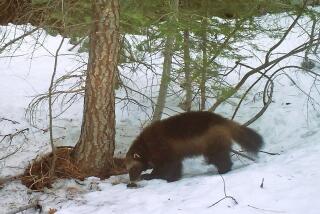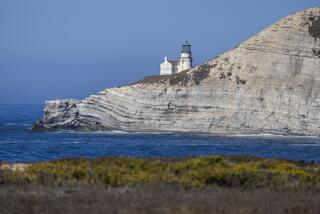Preserving a Piece of African Savanna in Eastern Ohio Grassland : Animals: The Wilds is where the deer, antelope and other endangered species play. Some hope it will become a prototype for zoos nationwide.
CUMBERLAND, Ohio — Four African gazelles, free to run on the nation’s largest endangered wildlife preserve, clustered near a fence.
For these endangered animals born in zoos, it was only natural.
“They’re used to being in captivity. They stay near the fence because that’s where they’re comfortable,” said Mark Artzner, director of development of the Wilds, a 24-square-mile reclaimed strip mine in eastern Ohio.
“But gradually you’ll see them getting more adventurous.”
Once the gazelles do start exploring, they’ll roam the preserve with rhinos, giraffes, zebras and camels.
The gazelles are among 105 endangered animals sent to the Wilds, about 70 miles east of Columbus, from zoos across the country. The zoos are trying to save the animals from extinction. There are only 1,200 gazelles worldwide, and most of them are in zoos.
Most of the animals at the Wilds are native to Africa or Asia. Some, such as the red wolf and trumpeter swan, come from North America. Hundreds of other animals native to Ohio also live on the site.
The preserve, donated by American Electric Power Co., is primarily treeless, covered by knee-deep grass and dotted with lakes that provide drinking water for the animals.
“When you look out here, it looks more like an African savanna than eastern Ohio,” Artzner said.
The Wilds, surrounded by farms and small towns, is in the early stages of development. Only about one-10th of the area is being used, but there are plans for expansion.
The only other comparable endangered wildlife preserve in the country is the Fossil Rim Wildlife Center, about 75 miles southwest of Dallas. About one-third the size of the Wilds, Fossil Rim covers 3,000 acres and has 1,100 endangered animals.
The Wilds could become a prototype for zoos nationwide, said Mike Hutchins, director of conservation and science for the American Assn. of Zoological Parks and Aquariums. The Bethesda, Md.-based group represents local zoos and wildlife parks throughout the country.
“I do think you’ll see more of these larger, isolated preserves rather than the traditional urban parks,” Hutchins said.
Whether the Wilds succeeds will depend on the amount of financial support it receives from state and corporate leaders, he said. The Wilds has an annual budget of $900,000, mainly composed of corporate donations and local and state government money.
Opening the preserve to public tours also should help generate interest and money, Hutchins said. This summer the Wilds is open to tourists for the first time since animals began arriving three years ago. The operators expect about 60,000 visitors through Labor Day. Through early July, the park was averaging about 5,000 visitors a week.
But attendance is not the bottom line.
“Our focus is on education and research,” Artzner said. “This isn’t an amusement park. That’s not what we’re aiming for.”
Wildlife scientists at the preserve are trying to develop ways to breed the endangered animals. They are working on techniques to freeze embryos and perform artificial insemination in the wild.
Much of the research done at the Wilds benefits zoos and other animal parks because zoo research is limited by space, money and expertise, said Evan Blummer, the Wilds’ director of animal science and animal health.
But Mark Reef, resource director of the Washington-based National Wildlife Assn., said taking animals outside their natural environment changes their behavior and could affect the outcome of the research.
“I’m not convinced they’re doing that much,” said Reef, whose group represents state fish and game associations.
Blummer acknowledged that it is difficult to determine what effect it could have.
“We know next to nothing about some of these animals,” he said. “But remember, most of these animals were born in captivity at zoos.”
Educating the public is another mission of the Wilds. That’s one reason why park guides drive visitors through the preserve in vans.
“We want people to understand what’s going on with the rhinos, giraffes and what they’re looking at,” Artzner said.
The biggest challenge facing the Wilds staff is trying to strike a balance between curious visitors and maintaining a natural environment for the animals. Management has considered limiting the number of tours and requiring reservations.
“The big question is how we manage the human population out here,” Artzner said. “We don’t want to look out and see traffic jams on the preserve.”
More to Read
Sign up for The Wild
We’ll help you find the best places to hike, bike and run, as well as the perfect silent spots for meditation and yoga.
You may occasionally receive promotional content from the Los Angeles Times.






